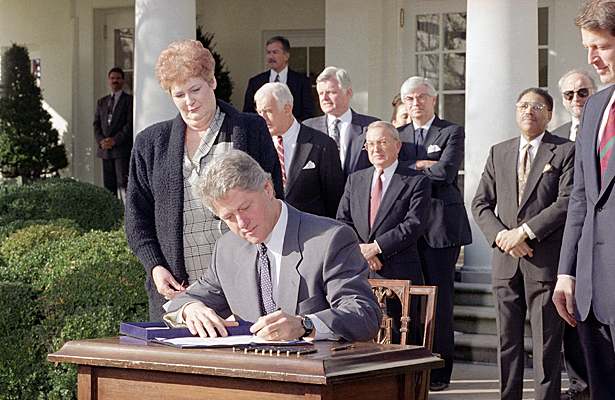The Family and Medical Leave Act at 20: Still Necessary, Still Not Enough
Two decades ago, President Bill Clinton signed the FMLA. It remains the only piece of legislation aimed at helping to manage the work-life balance.

Twenty years ago today, on February 5, 1993, former President Bill Clinton signed his first bill into law: the Family and Medical Leave Act. The Family and Medical Leave Act, also known as FMLA, allows up to 12 weeks of unpaid, job-protected leave to workers in order to recover from a serious medical condition, provide care for a seriously ill family member, or care for a new child. The FMLA remains to this day the only piece of federal legislation specifically focused on helping workers manage their dual responsibilities in the workplace and in the home.
It was no accident that this was the first piece of legislation Clinton signed, as presidents often use the first bill they sign into law as a way to convey a message about their priorities and what kind of leader they will be. President George W. Bush signaled his conservative roots by first signing House Joint Resolution 7, which honored the 90th birthday of former President Ronald Reagan. President Barack Obama's first signing was of the Lilly Ledbetter Fair Pay Act, which extended the statute of limitations for pay equity lawsuits, and signaled his support for the women voters who were so crucial in his election.
Back in 1993 when Clinton took office, it was already clear that our families were changing. Signing the Family and Medical Leave Act showed recognition of this new reality. At the time more than half of mothers were either the breadwinner for their families or shared that responsibility with a partner—which has only increased in the decades since. Long gone were the days when most families had a full-time, stay-at-home caregiver, and the government responded with a new policy to reflect that fact.
But the policy battle was not easily won. The fight for the FMLA had started nearly a decade before, and built upon the legacy of state level family leave legislation. It was initially drafted while President Reagan was still in office, and passed through Congress but was vetoed by former president George H.W. Bush before Clinton came into office and signed it into law (notably, his son George W. Bush also vetoed an expansion of the FMLA to provide up to 26 weeks of unpaid leave to workers who are caring for a wounded service member in active duty, which was later signed into law by President Obama.)
Despite the struggles to see it enacted, the Family and Medical Leave Act and has been shown to cause employers, by their own account, little to no problems even after having been used by workers more than 100 million times. And while the FMLA was, and is, vitally important for workers, the fact that we have seen no additional progress in work-life legislation over the last two decades, in spite of lagging behind the rest of the world in this regard, is an embarrassment at best.
No one should underestimate the positive impact that the Family and Medical Leave Act has had on workers' lives. While the leave is unpaid, it does provide job protection and the extension of health insurance benefits for workers while they are unable to work. Prior to its passage, if a worker had a heart attack, or needed time off to take their spouse to chemotherapy appointments, or to provide care to a newborn or newly adopted child, there was nothing to guarantee that they would not be fired. And considering the fact that most FMLA leave is taken to recover from a serious illness or accident, or to care for an ill or injured family member, holding on to employer provided health insurance is clearly important.
But the Family and Medical Leave Act is not perfect, nor does it address all of the needs workers have. Because it is unpaid many workers cannot afford to take the leave even when they need to - in fact, nearly half of those who qualified for the leave but did not take it said that was due to financial reasons. And about four-in-ten workers do not qualify for FMLA leave in the first place, since it is restricted to workers who have been employed at their current job for at least a year, have worked a minimum of 1,250 hours in the 12 months before their leave is to begin, and who work for an employer with at least 50 employees within a 75-mile radius.
The other half of workers who are not covered by the Family and Medical Leave Act may be able to cobble together some complicated amalgamation of earned sick days or vacation time, but even access to those benefits are not guaranteed by law. According to data collected by the Bureau of Labor Statistics as part of the American Time Use Survey, 36 percent of American workers over the age of 18 do not have access to any form of paid leave at all—not paid sick leave, not paid parental leave, not paid vacation. The United States remains the only industrialized nation that does not offer paid maternity leave, in addition to being the only advanced economy that does not guarantee the right to earned sick days. This is why the Center for American Progress has proposed Social Security Cares, a national paid family and medical leave insurance program that would cover the same life events that are covered under the FMLA and offer partial wage replacement that was funded through a small (less than one-half of one-percent) increase in the payroll tax.
When former President Clinton signed the Family and Medical Leave Act in 1993 he acknowledged the way that our families and workplaces have changed and the need for common sense work-family policies so that no one has to choose between being a good worker and a good family member. Unfortunately progress has stalled in the two decades since. Hopefully President Barack Obama's second term will start us moving again in the right direction.
